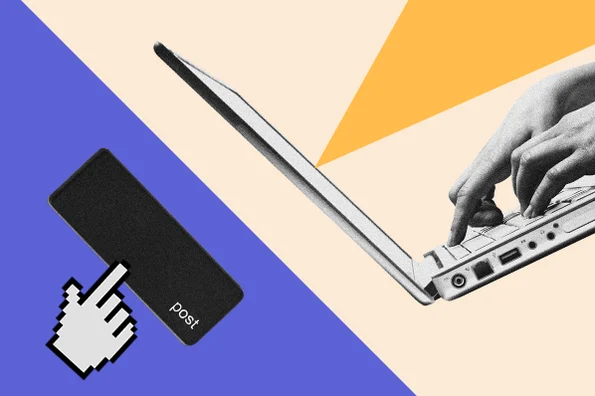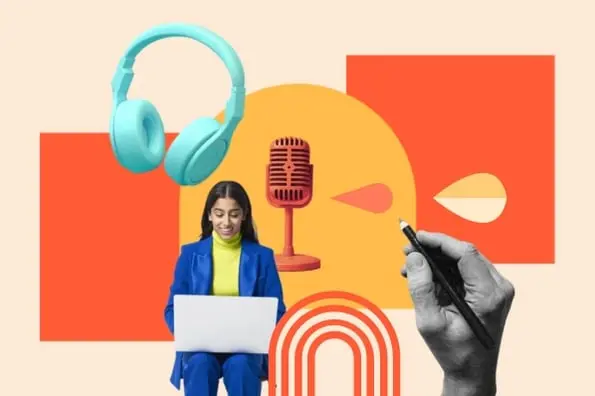Are you struggling to monetize a blog? Don’t fret. Whether running a personal blog or managing the official blog on your company's website, monetizing your blog is achievable with the right know-how.

There's no exact formula to start making money, but there are strategies you can start experimenting with to see what works best for your content, your business, and your audience. Below, we'll dive into some of these ideas and get advice from HubSpot's own blog leaders.
Don’t have a blog yet? No sweat. HubSpot’s free blog maker can get you started on your content journey with a custom blog in minutes.
Table of Contents
Blog Monetization
When you think about blogging, you might think that it's a lot of work for little reward. However, blogging can be one of the top ways you drive revenue to your brand or company. Blog monetization is the process of making money from your blog, whether it's for a personal brand or your enterprise company.
How do blogs make money?
Before we dive into the monetization strategies, you might wonder, "How will my blog make money?" Your blog can make money in several ways, including lead generation, affiliate marketing, brand partnerships, collaborations, or advertising.
Check out the video below for more blog monetization tips, examples, and a step-by-step guide.
Now that we know a few ways blogs can make money, let's dive into the top monetization strategies for your blog.
How to Monetize a Blog
- Map blog posts to specific conversion points.
- Include information about your product or service in your blog posts — but do so sparingly and thoughtfully.
- Build a lead funnel for your product.
- Offer sponsored content opportunities to other brands.
- Provide coaching services.
- Market your freelance writing skills.
- Participate in affiliate marketing.
- Offer online courses.
- Host webinars and live events.
- Create a membership or subscription program.
- Sell advertising space.
- Start a podcast.
- Write sponsored reviews or product roundups.
- Utilize email marketing.
- Implement a paywall.
1. Map blog posts to specific conversion points.
You can use your blog to drive leads and conversions as a company.
"Conversion is the foundation of blog monetization," says AJ Beltis, senior marketing manager of content strategy and media conversion at HubSpot.
Beltis continues, "Whether it's an e-commerce purchase, a demo request, or a content offer download, it's imperative to have your blog posts point to an intentional, related next step in the buyer's journey."
So, you might be asking yourself, "How can I do that?"
Beltis' advice is to ask yourself what somebody reading this specific blog post would want or need from your company. Then, you should create the required assets to make that conversion happen through website pages, forms, or content.
After that, you'll naturally place your calls-to-action to that next step in the blog post so readers are reminded about your recommended next step.
"By placing these CTAs in appropriate blog sections, you're more likely to capture readers' attention with high intent. This process puts more readers on the path to becoming paying customers for your business," Beltis adds.
2. Include information about your product or service in your blog posts — but do so sparingly and thoughtfully.
When you're writing blog posts, it's important that each post isn't just a sales tactic. Your blog posts should provide value to everyone, not just your customers.
However, you should still mention your product or service.
"If you're writing content about the best tools for X, and your product or service is a good solution to that user's search query, I'd highly recommend including it in your total roundup of tools to increase exposure and, ideally, drive more leads and customers towards your product," says Caroline Forsey, principal marketing manager on the blog team.
"This is one of the most effective ways to monetize your blog for the long-term," she says, "particularly since that same piece of content might provide your business with leads 3-5 years into the future."
Again, this doesn't mean you should always and only promote your product or service.
Forsey adds that you risk damaging your blog's reputation if you do this too often or outside of the appropriate context.
"Readers don't want to see a random 'buy my product!' CTA in a piece of content irrelevant to your product," she says, "and, if they feel like your content is actually just a gimmick or hidden advertisement, they'll distrust your brand as a whole."
To avoid this, Forsey suggests only mentioning your product or service where it makes sense and in a list of other tools you'd recommend for businesses, so they feel you're arming them with helpful information so they can make their own decision best suited for their needs.
"Trust me: if readers enjoy reading your content and feel your brand is genuinely helpful, they'll give your product or service a second look," she says.
3. Build a lead funnel for your product.
If you work at a B2B company or have a long sales cycle, reading a blog post is usually a customer's first interaction with their purchase. It's also the most crucial stage of the inbound funnel.
Attracting your audience's attention with helpful educational content creates a larger pool of people to convert into leads and close customers. Your blog marks the start of a relationship with your customers.
Lestraundra Alfred, the managing editor of Marketing News, says, "If you're looking to gain exposure from your blog, your content should help bridge the gap between the problem the reader is trying to solve, and your product, which can serve as a solution.
By creating content your ideal customer is searching for and interested in, you can build a solid community of readers who are a great fit for your product and, when nurtured, can turn into customers for your business."
Ideally, you'll want to craft compelling blog content that your audience can discover easily through a Google search or social media.
You can also pay to amplify your distribution on Facebook, which has the best targeting tools out of all the social media sites and is cost-effective, or through paid search, which can thrust you to the top of a high-volume Google SERP, although some keywords are expensive.
After people start reading your blog content more and want to read it consistently, they'll sign up for your blog's email subscription. Once strangers to your brand, they're now regular visitors.
When these visitors read enough blog posts, you can entice them to download conversion offers, as Beltis mentioned. Then, you can then nurture qualified leads with more blog posts and lead generators through email or Facebook ads.
Consistently educating them and helping them solve their problems will build their trust, making it more likely they'll move to the middle of your funnel when ready.
And once you see them researching your product or service by reading case studies, requesting a demo, or trying to contact sales, you can move them to the bottom of the funnel, where sales will qualify their fit as a customer.
Sales will close some of these leads into customers, and they'll thank you when they do. Your blog introduced its customers to your brand.
4. Offer sponsored content opportunities to other brands.
Publishers like BuzzFeed and The Dodo produce content that floods social media daily. And they make money by helping other brands do it too.
Brands will collaborate with their video production, social media, and analytics teams to craft posts and videos that follow their formula for virality. Then, publishers distribute this sponsored content to their massive social media and website followings.
This content is similar to the publishers' native content, so their audience will enjoy reading it, exposing their clients to a huge, engaged, new viewership and boosting their followings and audience engagement.
Suppose your blog generates a significant amount of traffic. In that case, you can leverage your editorial expertise and audience reach to help smaller brands tell captivating stories to a bigger and better viewership.
Doing sponsored content right can pay huge dividends for your brand. It creates another revenue stream, and partnering with other marketing minds can help your team unleash unprecedented creativity.
In fact, T Brand Studio, the New York Times native ad business, crafted paid posts that captured as much engagement as some of nytimes.com's highest-performing articles.
5. Provide coaching services.
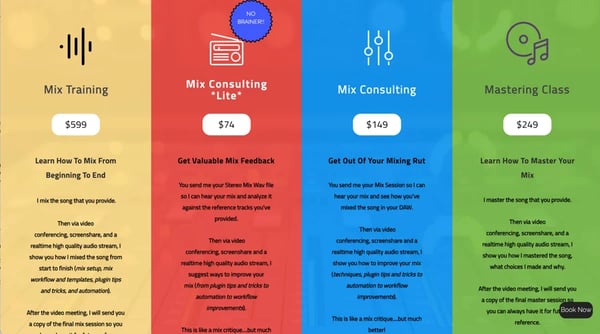
Your blog posts can serve as a teaser for how much your readers can learn from you about a particular subject matter.
If you write about enhancing specific skills like selling, social savviness, sports, cooking, and music, your blog posts can only teach your readers so much. They need to practice these skills in real life to see substantial improvement.
But if your readers practice these skills independently, they'll only get so much better. If they want to improve, training with a coach will guide them toward success faster than anything else.
Think about it. What would improve your basketball skills the most? Reading Michael Jordan's book about shooting and practicing his tips by yourself? Or reading his book and then taking shooting lessons with him?
If you're running a personal brand, as a coach, your blog is your most important marketing asset. It helps your potential clients improve themselves while giving them a glimpse into what life would be like if they achieved one of their life-long goals.
Your blog inspires readers to strive for their dreams. And when they're more motivated to reach their potential, they'll usually want an expert directing them toward greatness, not just themselves.
The above image shows coaching services offered by 1on1mixing, where people can learn to mix and master their songs.
6. Market your freelance writing skills.
If you're a freelance blogger, you must show potential clients you can write compelling content. To do this, you could attract their attention with your previous work, but you usually don't have control over those topics. So what if they don't pique their interest?
The best way to show potential clients you can write compelling content is by engaging them with your content. When you start a blog, you have access to your post's performance metrics and complete control over the topics you cover.
This allows you to write content you know your target audience will devour, attracting more and more potential clients to your blog.
And once they realize they rely on you for content marketing advice, they'll know they can trust you to help them improve their content marketing.
For instance, Eddie Shleyner, a freelance copywriter and content marketer, markets his business, called VeryGoodCopy, by writing articles about copywriting, content marketing, and psychology.
His pieces are so engaging and insightful that organizations like The North Face, Geico, and Mercedes Benz hire him to write articles, eBooks, landing pages, website copy, and email campaigns.
7. Participate in affiliate marketing.
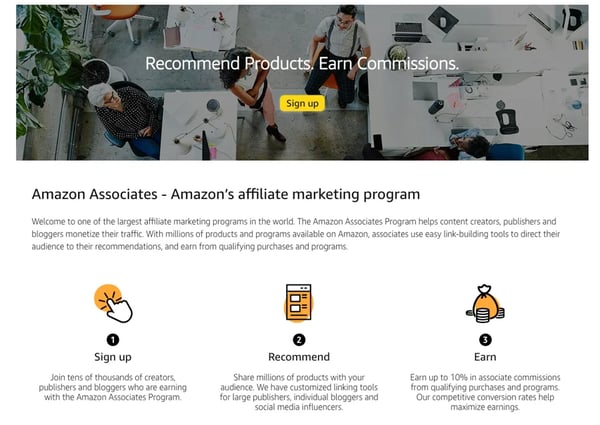
Affiliate marketing is one of the best ways to monetize a blog when you don't sell a product or service. It's a relatively simple process too.
First, you'll partner with an e-commerce platform or businesses with affiliate programs and pick relevant products to promote on your blog.
Your partners will then send you custom links to their product pages that can track customers referred by your blog. And if someone clicks on the link and buys the product from one of your posts, you'll earn a commission.
One of the most popular affiliate marketing programs is Amazon Associates. You can choose from over one million of Amazon's e-commerce products to advertise on your blog and earn up to 10% commission.
Out of all the ways you can make money blogging, affiliate marketing requires the least time, money, and resources. You don't have to build, market, or sell a product or service, and inserting affiliate links in your blog posts costs no money.
All you have to do is compel readers to buy something with your content writing skills.
8. Offer online courses.

Similar to coaching, providing online courses is an excellent way to generate revenue while providing value to your readers. However, maybe you don’t have the bandwidth to provide one-on-one coaching services, or perhaps that’s just not your style.
Instead, channel your time and expertise into creating educational assets like videos and written content based on your blog and expertise.
Then, you can give readers a taste of what your course offers using your free content and entice them to purchase your course to learn more.
Been itching to learn how to grow mushrooms? Check out the online course example above from GroCyle.
9. Host webinars and live events.
Not everyone is ready to commit to a complete online course or coaching session, and that’s okay. However, you can still monetize your blog and provide educational value to your readers by hosting webinars and live events.
Webinars and live events may attract readers interested in your content and want to be involved in a community of like-minded individuals.
Webinars and live events are a great way to foster a sense of community among people in your field, all while keeping the action local to your brand and your assets.
Depending on your niche, consider hosting monthly or quarterly online events and charge admission for people to join in on the fun.
10. Create a membership or subscription program.
.webp?width=600&height=291&name=how%20to%20monetize%20a%20blog_42023-Jun-02-2023-06-10-31-2552-PM%20(1).webp)
A membership or subscription program is about offering a premium experience to readers of your blog.
A premium membership offering will be custom to your blog's niche. However, the basic principles remain the same. You offer subscribers exclusive content, resources, and community access for a monthly fee.
You may be familiar with Patreon, where creators and personalities offer a membership experience to fans that gives them access to behind-the-scenes content and exclusive offerings.
You can undoubtedly use Patreon in conjunction with your blog. However, creating an in-house membership program means you don’t have to share the profits with anyone!
11. Sell advertising space.
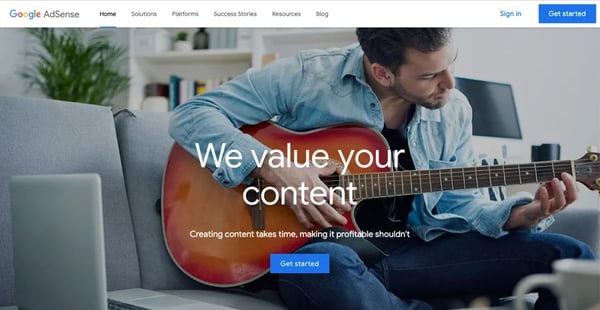
We’re partial to Inbound over here at HubSpot. However, selling advertising space is a classic outbound technique that you can use to monetize your blog.
Using tools like Google Adsense or other display network solutions, you can sell space on your website to be automatically populated with ads and get paid based on how often they are viewed/clicked.
If you’ve ever been on a website and saw an advertisement on the sidebar or banner, that's a display ad. The more monthly website visitors your blog receives, the more money you’ll make with ads.
Of course, you’ll share some of that revenue with the display partner.
12. Start a podcast.
These days, everyone and their mother has a podcast. That’s because it’s easy to get started and simple to monetize.
If you have an existing blog, especially one with a decent amount of traction, you should consider starting a podcast to continue the conversation.
Of course, the viability of your podcast depends on your niche, but you can use your blog as a pipeline to turn readers into listeners.
In terms of monetization, the goal of a podcast is to sell ads. If you can drive a lot of traffic from your blog to your podcast and generate a listening base, advertisers will pay top dollar to have you discuss their products/services on air.
13. Write sponsored reviews or product roundups.

Another way to monetize your blog is to write sponsored reviews and product roundups. This strategy works well if your niche is lifestyle or hobby-based and readers often research online before purchasing related items.
The example above is a product roundup blog post for the 15 Best Boxing Gloves of 2023, and it’s no mistake which products ended up on the list.
Product manufacturers will pay handsomely to have their offerings included in blog post reviews and product roundups because the extra eyes on their products translate to more sales (and more money in your pocket).
14. Utilize email marketing.
If you have a blog, then you more likely than not have an email list. If not, consider implementing custom sign-up forms on your site to gather that valuable info from your readers.
Email lists are crucial for alerting your readers of updates and new posts, but you can also leverage them for monetization.
For example, you can use your email list to support your affiliate marketing efforts and drive traffic back toward your blog to increase traffic and bolster any of the monetization strategies listed above.
You can use your email list as an advertising arm to promote products and services but remember to provide value to your readers above all else and never make them feel inundated with unhelpful promotional content.
15. Implement a paywall.
We don’t recommend this strategy for most blogs, but you can monetize by charging people to read your content, period. The New York Times is a perfect example of this, with its classic paywall that pops up when you try to read an article without a membership.
If you expect people to pay up to read your content, they will expect exclusivity, impeccable content, and an exceptional reputation.
Most of the strategies in this article are based on offering free, valuable content to readers and offering monetization opportunities along the way.
However, suppose you have notable influence and prestige within your field. In that case, you may have the chance to charge people to read your posts because they know they can’t get the same quality content anywhere else.
Start Making Money with Your Blog
Choosing your monetization strategy will depend on the type of blog you're running and the type of product or service you offer.
To up-level your blog, learn how to set yourself up for success and avoid the top blogging mistakes.
Editor's note: This post was originally published in March 2018 and has been updated for comprehensiveness.





![How Often Should You (or Your Company) Blog? [New Data]](https://blog.hubspot.com/hubfs/how%20often%20should%20you%20blog%20%28external%20research%29_featured.png)
![19 Types of Blogs that Make Money in 2024 [+Examples]](https://blog.hubspot.com/hubfs/blogs-Jan-05-2024-05-12-25-3281-PM.png)
![The Top 3 Reasons Consumers Read Blogs & How to Attract Them in 2024 [New Data]](https://blog.hubspot.com/hubfs/202_Reasons-Consumers-Read-Blogs.png)


